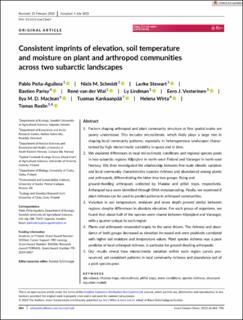| dc.contributor.author | Peña-Aguilera, Pablo | |
| dc.contributor.author | Schmidt, Niels M. | |
| dc.contributor.author | Stewart, Lærke Søndergaard | |
| dc.contributor.author | Parisy, Bastien | |
| dc.contributor.author | van der Wal, René | |
| dc.contributor.author | Lindman, Ly | |
| dc.contributor.author | Vesterinen, Eero J. | |
| dc.contributor.author | Maclean, Ilya M. D. | |
| dc.contributor.author | Kankaanpää, Tuomas | |
| dc.contributor.author | Wirta, Helena | |
| dc.contributor.author | Roslin, Tomas | |
| dc.date.accessioned | 2024-04-17T12:57:40Z | |
| dc.date.available | 2024-04-17T12:57:40Z | |
| dc.date.created | 2023-09-04T10:52:44Z | |
| dc.date.issued | 2023 | |
| dc.identifier.citation | Peña-Aguilera, P., Schmidt, N. M., Stewart, L., Parisy, B., van der Wal, R., Lindman, L., Vesterinen, E. J., Maclean, I. M. D., Kankaanpää, T., Wirta, H., & Roslin, T. (2023). Consistent imprints of elevation, soil temperature and moisture on plant and arthropod communities across two subarctic landscapes. Insect Conservation and Diversity, 16(5), 684-700. | en_US |
| dc.identifier.issn | 1752-458X | |
| dc.identifier.uri | https://hdl.handle.net/11250/3127067 | |
| dc.description.abstract | 1. Factors shaping arthropod and plant community structure at fine spatial scales are poorly understood. This includes microclimate, which likely plays a large role in shaping local community patterns, especially in heterogeneous landscapes characterised by high microclimatic variability in space and in time.
2. We explored differences in local microclimatic conditions and regional species pools in two subarctic regions: Kilpisjärvi in north-west Finland and Varanger in north-east Norway. We then investigated the relationship between fine-scale climatic variation and local community characteristics (species richness and abundance) among plants and arthropods, differentiating the latter into two groups: flying and ground-dwelling arthropods collected by Malaise and pitfall traps, respectively. Arthropod taxa were identified through DNA metabarcoding. Finally, we examined if plant richness can be used to predict patterns in arthropod communities.
3. Variation in soil temperature, moisture and snow depth proved similar between regions, despite differences in absolute elevation. For each group of organisms, we found that about half of the species were shared between Kilpisjärvi and Varanger, with a quarter unique to each region.
4. Plants and arthropods responded largely to the same drivers. The richness and abundance of both groups decreased as elevation increased and were positively correlated with higher soil moisture and temperature values. Plant species richness was a poor predictor of local arthropod richness, in particular for ground-dwelling arthropods.
5. Our results reveal how microclimatic variation within each region carves pronounced, yet consistent patterns in local community richness and abundance out of a joint species pool. | en_US |
| dc.language.iso | eng | en_US |
| dc.rights | Navngivelse-Ikkekommersiell 4.0 Internasjonal | * |
| dc.rights.uri | http://creativecommons.org/licenses/by-nc/4.0/deed.no | * |
| dc.title | Consistent imprints of elevation, soil temperature and moisture on plant and arthropod communities across two subarctic landscapes | en_US |
| dc.type | Peer reviewed | en_US |
| dc.type | Journal article | en_US |
| dc.description.version | publishedVersion | en_US |
| dc.rights.holder | © 2023 The Authors. | en_US |
| dc.source.pagenumber | 684-700 | en_US |
| dc.source.volume | 16 | en_US |
| dc.source.journal | Insect Conservation and Diversity | en_US |
| dc.source.issue | 5 | en_US |
| dc.identifier.doi | https://doi.org/10.1111/icad.12667 | |
| dc.identifier.cristin | 2172019 | |
| cristin.ispublished | true | |
| cristin.fulltext | original | |
| cristin.qualitycode | 1 | |

